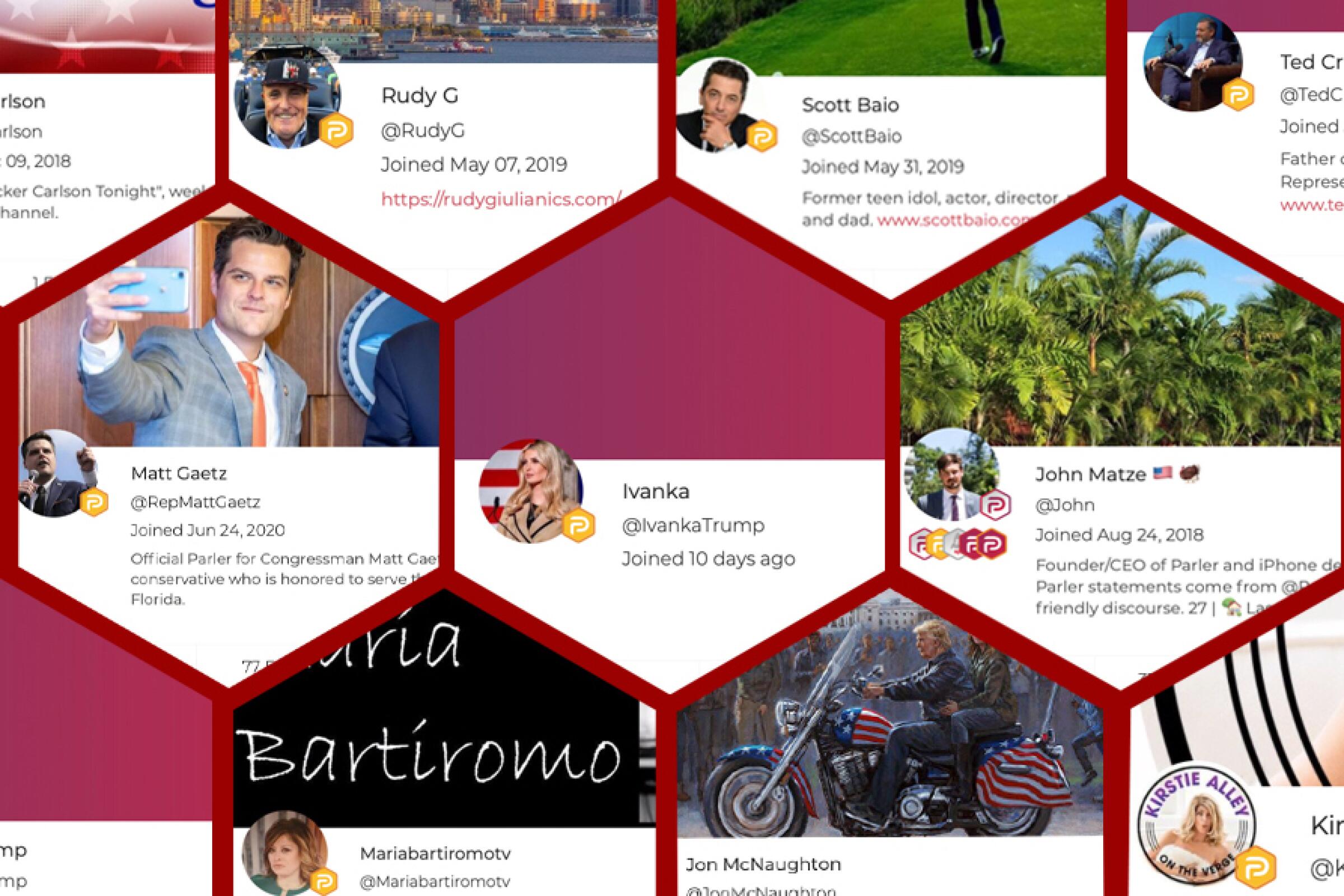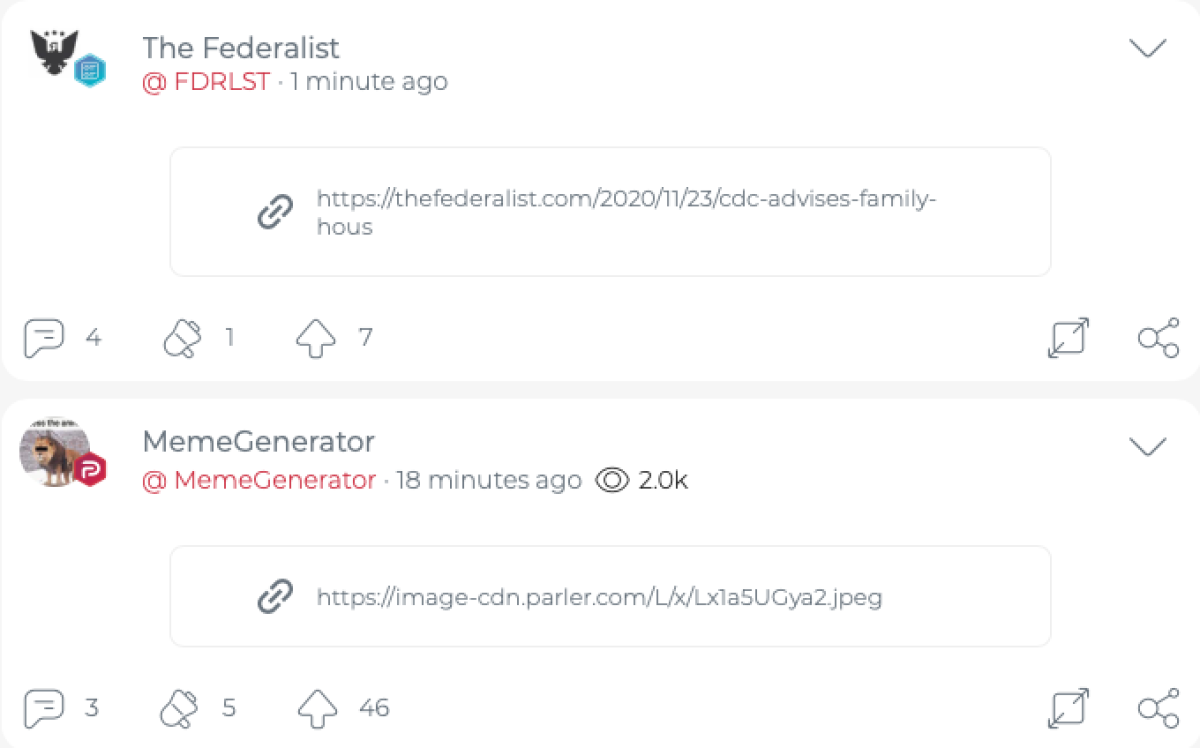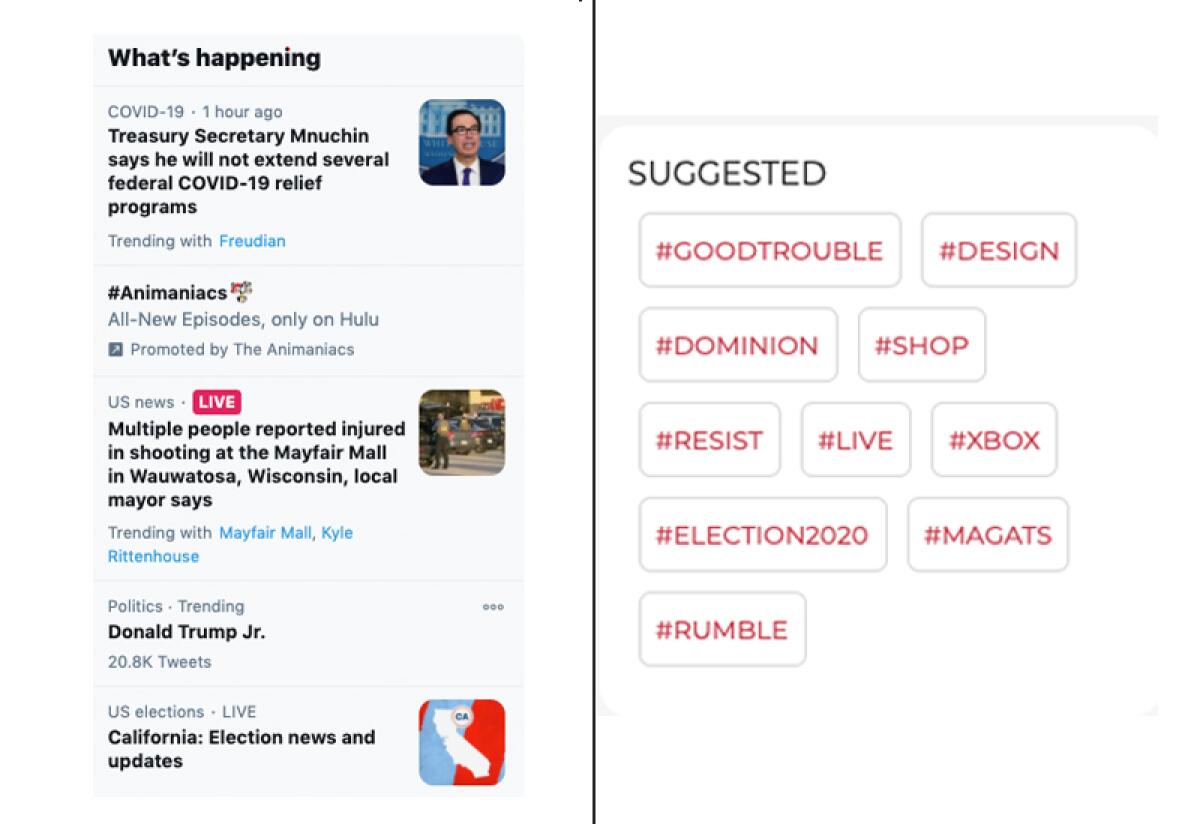The biggest entertainment stories
Get our big stories about Hollywood, film, television, music, arts, culture and more right in your inbox as soon as they publish.
You may occasionally receive promotional content from the Los Angeles Times.

Every social media platform has its flavor.
Instagram, with a logo inspired by boxy midcentury film cameras, offers a hipster-y promise of visual pleasure. Facebook, with its multiple columns framed by shades of reliable blue offers all the charm of filling out forms at the DMV. TikTok, with its bouncing musical note icon, makes you want to get up and dance.
Of course, Twitter, rife with optimism, takes as its mascot a sprightly songbird, labeling each of its fast-moving posts a tweet, as if its collective exchanges came together to form mellifluous birdsong. The site can be a joy. (Cue Seth Rogen getting high and live-tweeting “Cats.”) But it can also be a vulture’s nest.
The least well-known social media game is Parler — pronounced par-lur not par-lay, despite the name being French for “to speak.” In the lead-up to the presidential election and the chaotic days afterward, it’s become the go-to place for right-wing and extremist commentators and other political figures getting fact-checked and deplatformed by the bigger social media sites for spreading disinformation.
Conspiracy theorist Alex Jones, whose programs have been banned from Facebook, Apple, Spotify, Stitcher and YouTube, is on Parler. As are the far-right Proud Boys, which have been classified as a hate group by the Southern Poverty Law Center. Other Parler-ites include presidential offspring Eric and Ivanka Trump, as well as Fox News stars such as Tucker Carlson and Sean Hannity.
There’s even a bit of Hollywood in the mix, in the form of celebs such as Scott Baio, Kirstie Alley and new age-y keyboardist and TV presenter John Tesh, whose very public defection from Twitter brought out the quipsters. (“Serious question, did anyone know he was on Twitter?” asked an anonymous user named @NotHoodlum.)
On Parler, launched in 2018 and funded in part by conservative donor Rebekah Mercer, the politics and the aesthetics are red — literally, MAGA hat red.
Much of the site’s architecture, including its logo, its top navigation bar and its activity buttons, are the same fire-engine red as Trump’s famed baseball cap, a color that stirs urgency and excitement.
But unlike the MAGA hat, with its all-caps font that seems to be shouting at all times, the site does make some attempt at design. The “P” in the logo is rendered in a stylized modern font. The multitude of badges that denote user status are hexagonal, which, in combination with the gray sans serif typography that appears in posts, gives the whole site the feel of a pharmaceutical brochure. (Warning: Continuous use of Parler may lead to #EXCESSIVE #HASHTAG #USE and an ongoing desire to blurt #FAKENEWS.)
It has been burned. It has been memed. It has been stomped in protest.
Its design often feels like a crude rehash of Twitter: a column of “parleys” (the equivalent of tweets) appears in a stream at left, with the latest posts on top. The right-hand navigation bar features suggested hashtags and people to follow. In lieu of “likes,” the site has “upvotes” marked by an arrow. Instead of a retweet button, a small megaphone icon allows users to “echo” a post.
Parler has roughly 11 million account holders and 4.5 million daily active users (compared with Twitter’s estimated 330 million account holders; 187 million of whom use the site daily) — which means it’s in the birthing stages. And, at least for now, that means it’s clunky.
Profiles get stuck loading, links often don’t show previews and the search function is primitive. The only way to find anything is by searching hashtags, which means that countless posts on the site are little more than agglomerations of hashtags and the assiduous spammers who take advantage of them.

In addition, Parler limits what you can do if you don’t have a badge next to your name.
For example: You can’t respond to someone else’s post with a link to an article or a GIF unless you have one of Parler’s tiered verification badges. I tried sending funny cow GIFs to U.S. Rep. Devin Nunes (R-Tulare), a very active Parler user who famously sued an anonymous tweeter pretending to be his disgruntled cow, but my GIF responses were all rejected by the system because I didn’t have a badge. The most I could respond with was, “Mooo.” (Nunes hasn’t responded.)
As writer Arielle Pardes notes in Wired, this verification requirement makes the experience of Parler one-sided. “It’s hard to imagine someone without a big following going viral on Parler,” she writes. The site “functions less like the ‘public square’ it wants to be, and more like an ecosystem of right-wing bloggers, radio hosts and public figures to further amplify their thoughts.”
Our electoral map shows a country divided, but reality is more nuanced. Plus, poet Claudia Rankine and composer Osvaldo Golijov in our weekly arts newsletter.
Which brings me to the site’s elaborate verification system: Parler, it turns out, has more badges than an overachieving Boy Scout troop.
A yellow badge marks “verified influencers.” (The Trump kids, Carlson, Hannity and Jones all sport yellow badges, supposedly the equivalent of the blue Twitter check mark.) A silver badge with a rocket icon marks early adopters. Parler employees bear white badges with a red outline. A red badge with an orange outline not only marks you as verified, it lets other users know you are using your real name.
The most common designation is the “verified real user” badge, which is red and is used to verify “unique people in the Parler network.” The badge, quite confusingly, doesn’t verify your identity. As the site states: it “does not necessarily confirm the user is who they claim to be, just that they are Real Users.”
Parler refers to this as “Parler Citizen” status. To attain it, users are required to submit a selfie and identification. Last year, Parler Chief Executive John Matze told the Epoch Times in an interview that “when you see two people with a red badge, that means they’re a real person, and they’re having a real conversation with somebody.”
Given the nature of “conversation” on Parler, all a red badge really assures is that you’re not exchanging hashtags with a bot.

Ultimately, it’s Parler’s general detachment from reality that seems to be its most defining quality — not to mention its most surreal one.
What makes social media platforms so engaging is that you can see reactions, in real time, to the events of the day: an Oscar win, a World Series championship, an election result. But Parler’s design seems to diffuse and obfuscate these types of collective happenings.
I was monitoring both Twitter and Parler last week when news broke that Donald Trump Jr. had contracted COVID-19. The news quickly trended on Twitter yet failed to register on Parler. Trump’s name did not appear among Parler’s suggested hashtags, and clicking the “Discover” icon (Parler’s equivalent of “Twitter Moments”), turned up posts about free market economies and an old parley by a former “Duck Dynasty” star promoting a podcast about “Thanksgiving lockdowns.”
I found news of Junior’s status only after multiple hashtag searches. Eventually, a link to a story by the right-wing Epoch Times, a frequent source of misinformation, cropped up. The post was tagged #CCPVirus, part of an attempt to link the novel coronavirus to the Chinese Communist Party based on an unfounded theory that the disease was created in a Chinese weapons lab.
Likewise, on Monday afternoon, when Emily Murphy, the head of the General Services Administration, released a letter authorizing the formal transition of the federal government to President-elect Joe Biden, the news immediately dominated Twitter. On Parler, my feed featured a story about alcohol sales in Pennsylvania, a post from the former Fox Nation vloggers Diamond and Silk soliciting money for Trump’s reelection and a parley by the Federalist about Netflix’s adaptation of “Hillbilly Elegy.”
Trying to stay informed on Parler is like trying to divine the news by reading your grandparents’ junk mail.

As sites like Facebook and Twitter begin to crack down on disinformation, Parler frames itself as a “nonpartisan Public Square” in its community guidelines. “We want everybody to experience the First Amendment again, see free speech online,” Matze said in his Epoch Times interview. “And that’s what we’re pushing for.”
But there is a difference between free speech and an alternate reality filled with specious disinformation.
Even after all of the networks — including Fox News — had called the presidential race for Biden, and states such as Georgia had certified their elections, Parler remained a haven for an unending stream of posts contesting the election’s results (partly aided by Trump’s attorney, Rudy Giuliani, who was posting about “multiple pathways to victory” after the GSA had begun formal transition proceedings).
Trump reading “Russian for Dummies”? A naked Prince Harry? Not really. Alison Jackson has long used look-alike models to make art about deception.
Renée DiResta, a technical research manager at the Stanford Internet Observatory, noted in an essay published earlier this week in the Atlantic that creating a separate silo for all of the conspiracy theories could have one of two major effects: “It may limit the spread of conspiracy theories and reduce the possibility that Facebook and YouTube recommendation algorithms will draw casual users into the world of QAnon. But the bifurcation also raises the possibility that, among those who gravitate to niche platforms like Parler, the discussion may grow even more extreme.”
And the latter is a worrisome possibility. In a statement posted to its website earlier this month, the Anti-Defamation League noted that Parler creates “the potential for extensive and worrying commingling of extremists and non-extremists,” thereby creating further opportunities for extremism.
That gets at the most insidious thing about the site’s design — since the extremism is dressed up in an official gloss of badges and the digital trinkets of status.

The Epoch Times, purveyor of conspiracy theories such as “Spygate” (the unfounded claim that the Obama administration improperly spied on Donald Trump’s 2016 presidential campaign), sports a purple badge with a megaphone that marks it as a “Parler Media Partner” — and, presumably, a reliable source of information.
Parleys by verified influencers such as Ivanka Trump and the Los Angeles Police Department (that’s right, the LAPD is on Parler) appear amid posts by other verified influencers such as the Proud Boys, who recently shared a meme that mocked George Floyd’s death with explicit images of a sexual act, and Alex Jones, who recently posted that “Slave Camps” are “Headed to Biden’s America.”
It’s hard not to wonder what sorts of potentially violent “Pizzagate” standoffs the platform may yet inspire.
For now, Parler’s effects remain muted — with jokers on Twitter frequently referring to the site as “MeinSpace.”
President Trump as well as Donald Trump Jr. are sticking to Twitter (at least for now). And most mainstream media companies remain absent, except for the British tabloid the Daily Mail, which bears a purple media partner badge. Fox personalities such as Hannity, Carlson and Maria Bartiromo are active on the site, but there are no verified accounts for the larger Fox network. Meanwhile, the LAPD hasn’t posted since Veterans Day.
Posting by other influencers also remains sporadic.

Matze says that while unfettered speech is at the core of the platform, there are nonetheless some rules that govern Parler.
He has said the platform tries to control for phenomena such as pornography and spam. (Though I have come across plenty of both in my time on the site, including an infinite number of parleys offering Trump merch.) He also once said that “posting pictures of your fecal matter in the comment section WILL NOT BE TOLERATED.”
There is still poop. But it’s not just in the photos. It’s embedded in an architecture that seems hellbent on legitimizing and elevating hate and disinformation in the name of free speech.
The biggest entertainment stories
Get our big stories about Hollywood, film, television, music, arts, culture and more right in your inbox as soon as they publish.
You may occasionally receive promotional content from the Los Angeles Times.